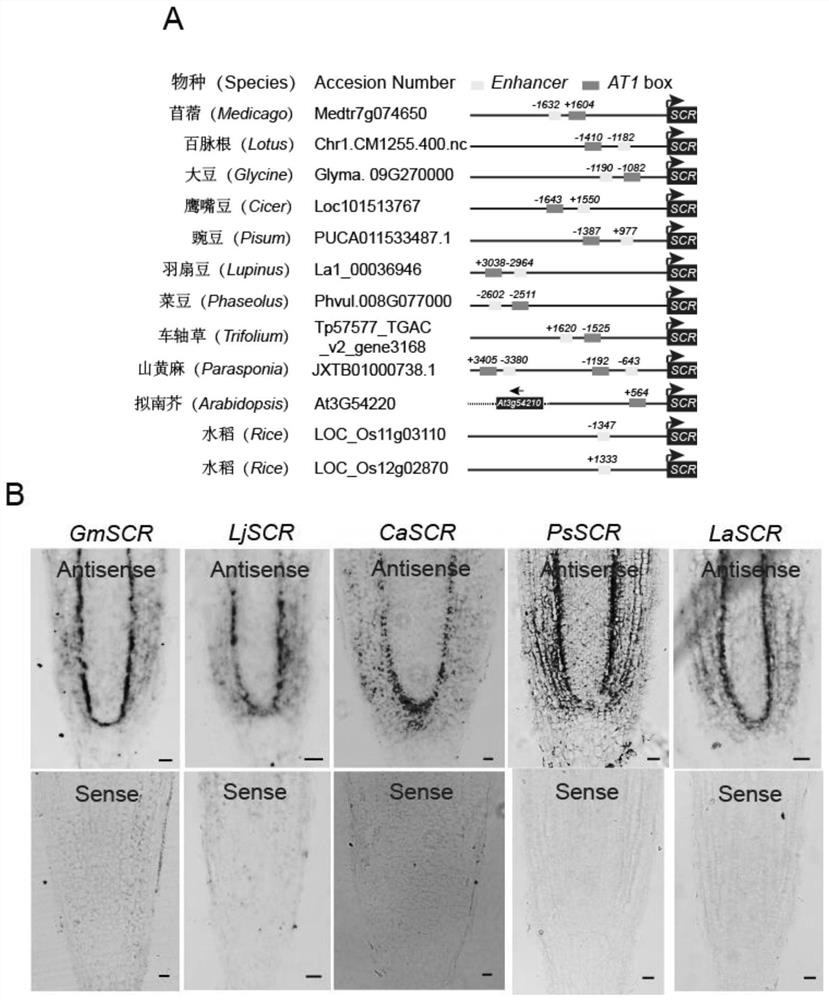Application of SHR-SCR in fate determination of cortex cells of leguminous plants and modification of division potential of cortical cells of non-leguminous plants
A cortical cell and cytokinin technology, applied in the field of cell attribute transformation, can solve the problem of poor understanding of the regulation mechanism of cell division
- Summary
- Abstract
- Description
- Claims
- Application Information
AI Technical Summary
Problems solved by technology
Method used
Image
Examples
preparation example Construction
[0118] Preparation of Agrobacterium rhizogenes competent cells
[0119] 1) Medium and solution
[0120] Ultrapure water, LB medium, 10% glycerol (v / v).
[0121] 2) Competent preparation
[0122] Step 1: Take the preserved strain, streak it on the LB plate containing the corresponding antibiotic, and incubate at 28°C for 24-48hrs.
[0123] Step 2: Pick a single clone in 3mL LB liquid medium, shake it overnight at 28°C, inoculate it into anti-LB medium at 1:100, and incubate at 28°C at 200rpm until OD600=0.5~1.0.
[0124] Step 3: Ice bath for 10 minutes, then centrifuge at 2,500 g for 10 minutes at 4°C.
[0125] Step 4: Remove the supernatant, first gently suspend the cells in 5 mL of ice-cold ultrapure water, then add 200 mL of ice-cold ultrapure water, and centrifuge at 2,500 g for 10 min at 4°C.
[0126] Step 5: Repeat step 4 once.
[0127] Step 6: Remove the supernatant, first lightly suspend the cells in 5 mL of ice-cold 10% glycerol, then add 200 mL of ice-cold 10% glycerol, and centrif...
Embodiment 1
[0175] Example 1. SCR is conservatively expressed in cortical cells of legumes
[0176] 1. MtSCR extended expression in root cortex and epidermal cells
[0177] The inventors found that the Medicago truncatula SCARECROW (MtSCR) gene is not only expressed in the quiescent center and endodermis of Medicago truncatula roots, but also in the cortex and epidermal cells of the roots, which is specific to Arabidopsis thaliana AtSCR. Sexual expression is very different in the resting center and endothelial layer of Medicago truncatula root ( figure 1 A~ figure 1 B).
[0178] 2. AT1 and Enhancer control the expression of MtSCR promoter in root cortex cells
[0179] The inventors performed a series of truncation experiments on the MtSCR promoter (2899 upstream of ATG of MtSCR; called pMtSCR(2899bp)), and combined the prediction analysis of cis-elements (http: / / plantpan2.itps.ncku.edu.tw / ) ), it was found that when AT1 Box (AT1 for short) and Enhancer (En for short) are missing in the promoter,...
Embodiment 2
[0188] Example 2: MtSCR participates in nodule symbiosis
[0189] 1. MtSCR participates in nodule symbiosis
[0190] The present inventors obtained plant materials of the Mtscr-1 (NF11026) and Mtscr-2 (NF20550) insertion mutants of Medicago truncatula Tnt1, which were grown at 24°C, 16h light / 22°C, 8h dark environment, and wild-type Medicago truncatula (WT) served as a control.
[0191] Sm1021 Rhizobium was inoculated when the plants grew to 3 days. After that, the nodule growth of the plants was measured on the 7th day, the 14th day, the 21st day, and the 28th day after the inoculation.
[0192] The result is image 3 As shown in A, the wild-type Medicago truncatula can produce nodules normally, while the Tnt1 insertion mutant Mtscr-1 (NF11026) and Mtscr-2 (NF20550) of Medicago truncatula can produce very low nodules on the 7th day after inoculation with rhizobia. The number of nodules on the 14th, 21st, and 28th day afterwards was also much lower than that of the wild type.
[0193...
PUM
 Login to View More
Login to View More Abstract
Description
Claims
Application Information
 Login to View More
Login to View More - R&D Engineer
- R&D Manager
- IP Professional
- Industry Leading Data Capabilities
- Powerful AI technology
- Patent DNA Extraction
Browse by: Latest US Patents, China's latest patents, Technical Efficacy Thesaurus, Application Domain, Technology Topic, Popular Technical Reports.
© 2024 PatSnap. All rights reserved.Legal|Privacy policy|Modern Slavery Act Transparency Statement|Sitemap|About US| Contact US: help@patsnap.com










